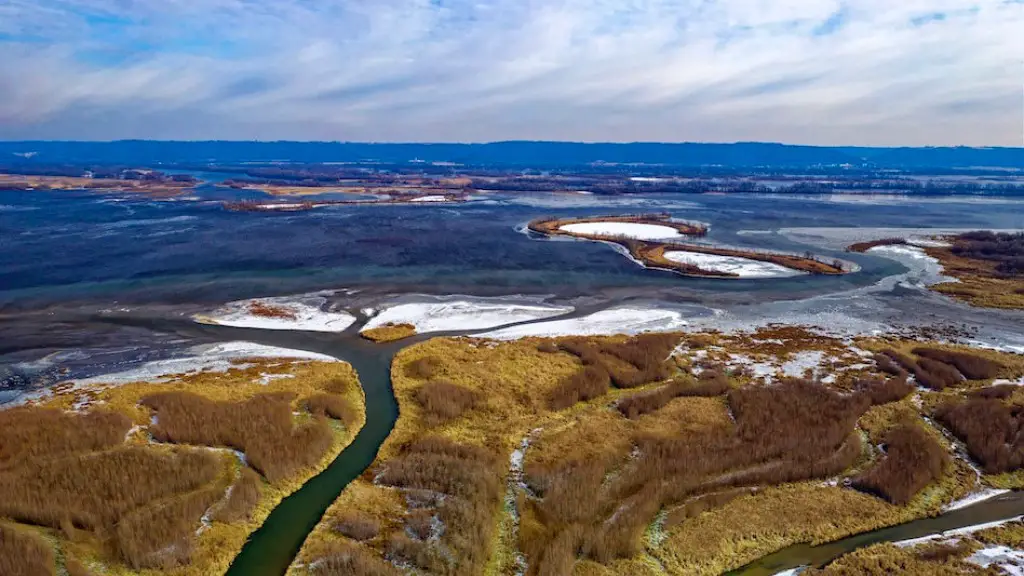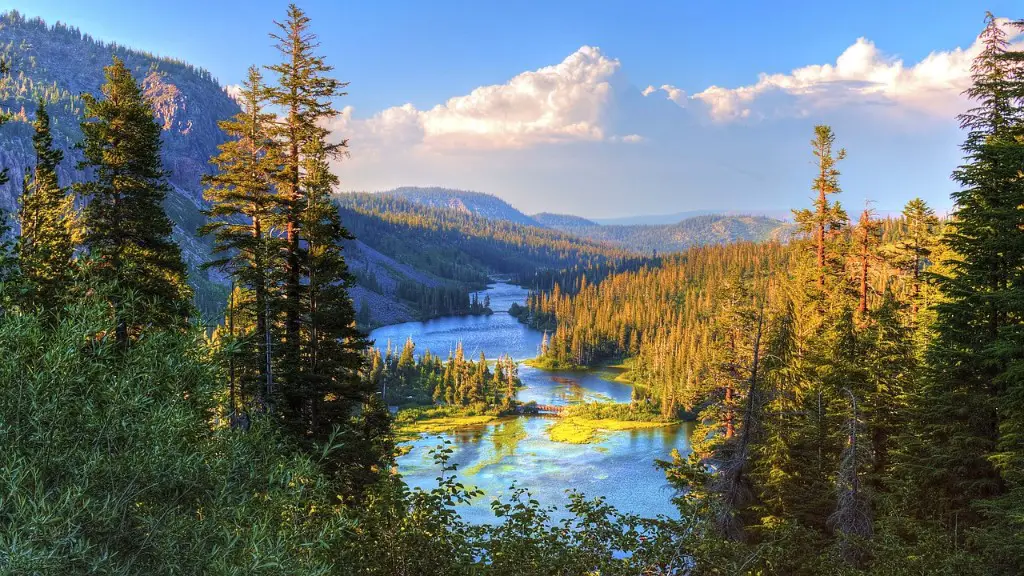The Mississippi River is the second longest river system in the US, and is an integral part of the American culture. Unfortunately, it is now under a threat of contamination due to commercial and agricultural activities. In recent years, there is an ongoing problem of it becoming increasingly polluted and putting the local lives of animals and humans at risk.
There are many factors that contribute to the pollution of Mississippi River. The main reason is agricultural runoff. Fertilizers, pesticides, and animal waste runoff enter the river, which leads to contamination of its waters and hazards to the local wildlife and people. Additionally, industrial runoff, agricultural waste, sewage, and oil spillage are other major sources that cause water pollution.
Unchecked pollution in the Mississippi River has resulted in numerous negative consequences. Toxic pollutants have been found in the waters, which leads to poor water quality and disrupts the balance of the ecosystem. Marine life has been especially affected, as various fish and animals have been found to be contaminated with pollutants like mercury and PCBs. Furthermore, due to the poor water quality large amounts of algae can be often seen floating on the surface of the river, leading to decreased water circulation and lack of sunlight penetration which in turn harms the entire aquatic life.
Another issue caused by the contamination of the Mississippi River is the formation of “dead zones”. These dead zones are areas in which almost no oxygen is present, as a result of nitrogen-rich agricultural runoff. This further indicates the changes in the river’s water quality and the damage done to the environment.
The problem of water pollution in the Mississippi River is a complex one. In order to find a viable solution, it is important to analyze the source of the problem. Scientists and experts in the field suggest that the biggest contributors to the water pollution are runoff generated from farms and factories. To fight against this issue, it is important that these activities are regulated and pollution-control measures are taken. Sustainable agricultural practices must be developed and the use of fertilizers, chemicals, and other pollutants needs to be curbed.
Communities along the river need to work together in order to protect their water sources. The government and environmental organizations have a duty to spread awareness and educate people on the seriousness of this issue and the necessary measures that need to be taken. Everyone should also be encouraged to exercise their right to clean water.
Though the pollution of the Mississippi River is a severe problem, with the proactive efforts of the authorities, local people and environmentalists, it is possible to bring about a cleaner, sustainable river system for the future generations.
A Look at the Causes of River Pollution
There are a variety of causes of river pollution in the US, but one of the biggest is agricultural runoff. As farms increase in size and intensity, the amount of fertilizer and chemicals used for agriculture and raising livestock increases, leading to increased levels of nitrogen, phosphorous and other pollutants in US rivers. Additionally, as more farms turn to animal-based agriculture, the waste from animals, including manure and herbicides, ends up in rivers and can cause serious water pollution. In certain areas, factory runoff can also contribute to river pollution, as large factories have been known to discharge pollutants, such as heavy metals and acids, directly into nearby rivers and streams.
The effects of river pollution can be far-reaching. As rivers become more polluted, the water quality in these rivers can decrease dramatically, leading to die-offs of fish and other wildlife. Pollutants, such as nitrogen and phosphorous, can create dead zones in rivers, as they promote an increase in algae growth, which can then deplete the oxygen in the water and kill off fish, aquatic plants and other wildlife. People living near polluted rivers can also be at risk, as their drinking water may be contaminated with high levels of pollutants, leading to health issues.
In order to reduce the amount of river pollution in the US, it is necessary to start from the source. Farmers should be encouraged or even required to use sustainable agricultural practices to reduce the amount of runoff that enters US rivers. Similarly, industries should be strictly regulated and inspected for compliance with environmental standards, ensuring that pollutants do not enter US rivers. In addition, local governments should invest in the cleanup and restoration of polluted rivers, in order to ensure that US rivers remain clean and safe for future generations.
The Impact of Water Pollution on Marine Life
Water pollution has a devastating impact on the aquatic wildlife living in and around the Mississippi River. The increasing levels of fecal coliform and nutrients, nutrients like nitrates and phosphates, affects the river’s water quality, lowering the oxygen levels and creating “dead zones”. This in turn has effected the marine life along the riverside, including fish, invertebrates and other organisms, who are unable to survive due to the deteriorating water quality.
Furthermore, the pollutants contaminate the fish and other aquatic life in the Mississippi River. This can affect the entire food chain, as these contaminated organisms are often eaten by other fish and animals. As a result, the entire aquatic wildlife, from the microorganisms to the fish, can become increasingly contaminated, leading to adverse consequences for the environment.
In order to protect the aquatic wildlife living along the Mississippi River, it is important to reduce the amount of pollutants entering the rivers. Sustainable agricultural practices must be adopted, industries must be regulated and inspected, and greater efforts must be made in order to clean and restore the river itself.
Looking at Mississippi River Clean Up Efforts
Due to the increasing pollution in the Mississippi River, conservation efforts have been made by a variety of organisations. The efforts began back in the 1990’s, when the state of Mississippi passed the Mississippi River Basin Initiative (MRBI), which aimed to improve and protect public health, preserve water quality and improve water-related activities such as fishing, boating and recreation.
Most recently, the Environmental Protection Agency (EPA) has been actively taking part in the efforts to clean up the Mississippi River. In 2017, the EPA launched the Mississippi River Basin Healthy Watersheds Initiative (MRBI), which aims to protect and restore critical watersheds in the Mississippi River Basin. The initiative is a collaboration between the EPA, the Department of Agriculture, the Department of Defense, the National Oceanic and Atmospheric Administration, and other federal and local partners. The initiative provides funding to projects that demonstrate innovative solutions to cleanup and restore the river’s water quality and reduce the amount of pollutants entering the river.
Organisations like the Mississippi River Network (MRN) have also been actively advocating for the protection of the Mississippi River. The MRN is a coalition of over 60 organisations, including conservation groups and local communities, dedicated to protecting the river system through policy advocacy and public engagement.
Public Support for Mississippi River Conservation
In order to protect the Mississippi River, it is important to have public support and involvement. The EPA, MRBI and MRN have all been actively engaged in educating citizens about the importance of the Mississippi River, and the need to protect it. Many local groups have been formed, such as the Mississippi River Alliance in Louisiana, to raise awareness and work towards river conservation. There has also been a growing interest in the local community in participating in river cleanup activities, such as the annual “river swap”, which is held in many communities along the Mississippi River.
Public support is essential in the fight to protect the Mississippi River. Therefore, it is important to continue to spread awareness and educate people on the importance of river conservation, as well as encouraging them to get involved in local conservation projects and efforts.
International Collaboration for Mississippi River Conservation
As the pollution in the Mississippi River continues to threaten the environment and the health of local citizens, international collaborations and partnerships have been increasingly important in protecting the river. In 2011, the US and Canada signed the Great Lakes Water Quality Agreement, which was an agreement between the two countries to work together to protect the Great Lakes and the Mississippi watersheds. The governments of the US and Canada have since worked together to implement and maintain common standards for water pollution control, identifying sources of pollution and implementing protective actions.
In addition, other international organisations such as the International Joint Commission (IJC) and the North American Commission for Environmental Cooperation (CEC) have also been actively involved in the protection of the Mississippi River. Through intergovernmental agreements, they have been working to advance specific policies, engage in education and research, and coordinate public awareness efforts on a variety of environmental issues, including water pollution and river conservation.
International collaboration and policy initiatives have been integral in the fight to protect and restore the Mississippi River. By working together, countries and organisations can take a much more effective and targeted approach to combating water pollution, and can ensure that the Mississippi River remains a safe and healthy environment for future generations.





